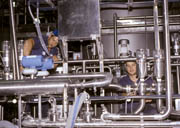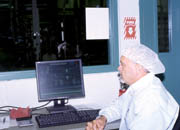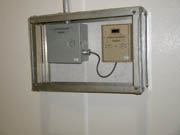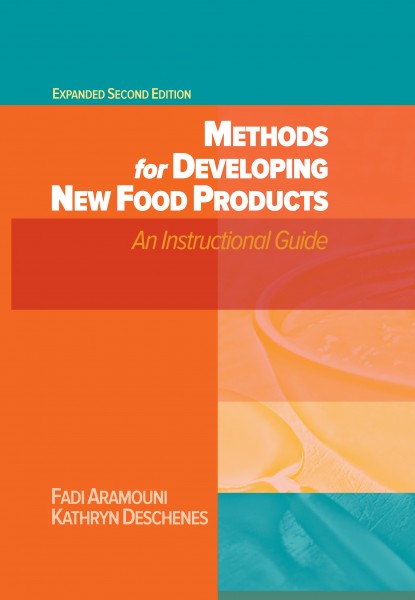When aseptic processing adds cost, the technology is a hard sell. But three entrepreneurs prove it can be a cost-saving process.

Four rogues named Charlie, Frances, Ivan and Jeanne might have done more to advance aseptic food processing than legions of the technology's proponents did over several decades.
The hurricanes that racked southern Florida in August and September caused sometimes prolonged power outages and other disruptions in the region. Loss of power could have been a disaster for the orange-juice tank farms where OJ concentrate is stored between harvests. Mercifully for Tropicana Beverages, the contents of the million-gallon tanks are processed aseptically. Power loss did not compromise inventoried product, a company spokeswoman confirms.

Hurricanes are dramatic events; power interruptions are prosaic. Both pose a threat to refrigerated foods. The difference is that, even when both are non-events, refrigeration still costs processors money. It's a cost that can be eliminated, however, if ingredients and finished products are processed aseptically and stored at ambient temperatures. With that as a business model, investors with lower profiles than Charlie, Frances, et al. constructed bulk blending and aseptic processing facilities last year. American Purpac Technologies LLC's plant on the Illinois-Wisconsin state line is targeting makers of high-acid juice concentrates who traditionally ship frozen concentrate to distributors for filling. Purpac aims to do for fruit concentrates what aseptic has done for tomatoes and, in the process, spur a boom in aseptic applications throughout North America.
David Madden, D. Scott Eckman and John Saladino conceived Purpac as a copacker serving the non-carbonated beverage market. "Taking cost out of the supply chain is at the core of everything we do," says Madden, the firm's president, and they do it by aseptically processing and packaging blends and concentrates that can be distributed nationally without refrigeration. In October 2003, two hot-fill lines that serve as cash-flow generators came on line. They were joined by two state-of-the-art aseptic processing lines that were commissioned January 15. Extensive staff training was conducted between those dates by internal and outside experts.
Some of the Beloit, WI, plant's features reflect 21st Century expectations. Security was a design consideration, with three entrances and exits. All workers, including temps, carry key cards. Cards that open critical areas such as the control room and QA lab are restricted to a handful of key personnel. The Bioterrorism Act's tracking and tracing requirements are satisfied with a scan-based system backed by electronic signature capture for ingredients and finished goods. "In the event of a recall, we could probably pull up all the batch data, all the CIP cycles and all the chemicals used in four minutes," claims Saladino, the company's chief financial officer. "We spent the money now to be the ultimate on the blending side."
For now, Purpac is more Big Idea than Big Project. The facility is comparable to a boutique steel mill: able to deliver small production runs at low per-unit costs through a mixture of automation and process efficiency. A $10 million initial investment bought multiple holding tanks and 2.5 miles of stainless steel piping, along with tangible evidence of a commitment to "the latest processing and packaging technology and looking for the next new thing," according to Eckman, chief executive officer. Computerized controls and information systems-a Process Pro ERP and recipe management package that interfaces with Rockwell controls and HMI software modified and integrated by Automation Solutions of America (ASA)-accounted for $1.2 million of the initial investment. Half of the 65,000-sq. ft. building is new construction, where aseptic processing is done. The balance is a renovated mattress warehouse, where hot filling is completed.
Automation minimizes the potential for human error, but the nature of aseptic also demands scrupulous attention to details and procedures. The challenge was to develop a culture in which sanitation is next to godliness and any deviation from the norm raises red flags. "Operating an automated system can be boring," Eckman allows, "but if the system burped-temperature dropped very fast or spiked, for example-it's not okay, you have to start all over, and you have to understand what went wrong."

No-scrimp fitments
Eckman applied a lifetime of food industry experience and a compulsive nature to devising a plant and work environment where stringent processes and procedures are second nature. "There's no such thing as a short cut: you're either sterile or you're not with aseptic, whether it's low or high acid," says Eckman. "You either hot fill properly or you don't." Operators working with concentrates costing $50 a gallon or more might feel pressure to overlook a hiccup in a 2,500-gallon batch. The management challenge is to ensure they don't.
Two Dean Foods veterans-QA manager Dick Bennett and a since-departed operations manager-helped indoctrinate new employees in strict sanitary procedures. "We have the mindset of being a dairy in the way we handle and treat products," says Eckman. The plant's 30 full-time employees are armed with equipment and systems that allow them to uphold sanitary standards.
It begins with a Class 1,000 clean room environment. Processing areas were engineered to meet the temperature, humidity and air quality standards specified in Federal Standard 209D, which sets a limit of 1,000 particles of less than 0.5 microns per cubic foot of air. It is the highest clean-room standard for food production, one notch below the specification for silicon-chip manufacture. Positive air pressure is maintained, and, given the amount of process steam, humidity is strictly controlled.
HEPA filters help meet the standard, but safeguards don't stop there. Plant access from the receiving dock is denied by an automated lock-down system tied to nitrogen dioxide and carbon monoxide sensors in the truck bay. Large fans evacuate the room's air when trucks enter and leave. When air quality returns to the same level as the processing area, the monitors signal the plant control system to unlock the access doors.
The evacuation fans are part of a network of approximately 400 discreet devices managed by the plant control system developed by ASA, a St. Charles, IL, integration firm with offices in Beloit.
Multiple networks move data back and forth from the ERP system, where recipes, scheduling and inventory, ingredient lists and regulatory data are managed, down to the device level on the floor. Included in the communications network are ControlNet for panels, DeviceNet for scales, a-SiNet for valves, Ethernet for the HMIs and Data Highway Plus for the fillers and aseptic processing systems. Project Engineer Steve Lewis and two colleagues began writing code and devising the logic behind processing and CIP cycles in January 2003; "by September, we had a usable system," he reports.
Hundreds of Waukesha Cherry Burrell mix-proof valves and Krohne mass flowmeters are included in the plant's infrastructure. Most of those devices run through the a-SiNet, a two-wire BUS popular in Europe. There are seven a-SiNet highways, with about 27 valves per network. Four inputs and four outputs for valve position and changes are relayed via flat cable, allowing the control system to evaluate and check every valve in a path, whether for processing or one of 40 CIP circuits. Compounding the complexity are six Walker-built 8,000-gallon holding tanks and five 3,000-gallon blending tanks. "It's tightly integrated and complicated," says Lewis. "If all conditions aren't met, a product or cleaning cycle won't run."
The focus of all those checks and balances is maintaining asepsis, and at the heart of the process are two multi-tube heat exchangers built by Advanced Process Solutions. "A lot of systems are built to run a narrow range of products at a fixed flow rate," says Dan Csizmadia, APS's engineering director. "This was designed to run a wide range of products and viscosities." Clean-head design that avoids flat surfaces in favor of tapered ones allows Purpac to run small particulates such as pulp through the one-inch tubes without concerns of particle buildup. The 19-tube clusters were engineered to handle viscous fluid with up to 8 percent particulate at a flow rate of 30 gallons per minute.
Model-T mentality
Flexibility is a copacker's stock in trade. At Purpac, processed concentrates flow to an array of fillers that handle totes ranging from two liters to 55 gallons. Bulk filling capabilities are being expanded with an Italian unit that can fill 1,000-gallon totes.
"We're able to push very thick products through the process, and the fillers are able to handle a wide variety of fitments," says Eckman.
While he believes the Beloit plant is a watershed development in the processing of high-acid fluids, Eckman has no delusions that industry change will occur without years of persuasion and trials. Nevertheless, the plant's existence serves as a rallying point for aseptic advocates. Aseptic guru Charles E. Sizer, one time director of Tetra Pak's aseptic pilot plant and now a principal in Naperville, IL-based Enhanced Beverage Co., is discussing a partnership with Purpac to install a high- and low-acid pilot plant with scraped surface heat exchangers in the facility.
By building a commercial processing platform, Purpac has given firms like Scholle a reason to pursue developments like new dispensing machines, fitments or alternative films.
"Until someone built a car, there was no reason to build an engine or design a transmission," Eckman notes. "We've built the car."
Some of America's leading food manufacturers are kicking the tires of the car in Beloit, evaluating the projections of cost savings for their supply chains. If they begin to place production orders, Eckman & company's vision will be vindicated.
For more information:
Dan Csizmadia, Advanced Process Solutions Inc.,
888-294-8118/812-280-7450,
danc@gotoaps.com
Steve Lewis, Automation Solutions of America,
815-599-5064,
slewis@AsofA.com

